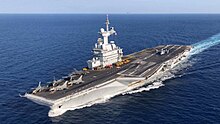
Back Letová paluba Czech Flugdeck German Αποκλίνον κατάστρωμα Greek Cubierta de vuelo Spanish عرشه پرواز Persian Pont d'envol French סיפון טיסה HE Ponte di volo Italian 飛行甲板 Japanese 비행갑판 Korean


The flight deck of an aircraft carrier is the surface from which its aircraft take off and land, essentially a miniature airfield at sea. On smaller naval ships which do not have aviation as a primary mission, the landing area for helicopters and other VTOL aircraft is also referred to as the flight deck. The official U.S. Navy term for these vessels is "air-capable ships".[1]
Flight decks have been in use upon ships since 1910, the American pilot Eugene Ely being the first individual to take off from a warship. Initially consisting of wooden ramps built over the forecastle of capital ships, a number of battlecruisers, including the British HMS Furious and Courageous class, the American USS Lexington and Saratoga, and the Japanese Akagi and battleship Kaga, were converted to aircraft carriers during the interwar period. The first aircraft carrier to feature a full-length flight deck, akin to the configuration of the modern vessels, was the converted liner HMS Argus which entered service in 1918. The armoured flight deck was another innovation pioneered by the Royal Navy during the 1930s. Early landing arrangements relied on the low speed and landing speed of the era's aircraft, being simply "caught" by a team of deck-hands in a fairly hazardous arrangement, but these became impractical as heavier aircraft with higher landing speeds emerged; thus an arrangement of arrestor cables and tailhooks soon became the favoured approach.
During the Cold War era, numerous innovations were introduced to the flight deck. The angled flight deck, invented by Dennis Cambell of the Royal Navy, was one prominent design feature that drastically simplified aircraft recovery and deck movements, enabling landing and launching operations to be performed simultaneously rather than interchangeably; it also better handled the higher landing speeds of jet-powered aircraft. In 1952, HMS Triumph became the first aircraft carrier to trial the angled flight deck. Another advance was the ski-jump, which fitted an angled ramp on the flight deck near the end of the aircraft's takeoff run; the change greatly reduced the distance required and became particularly useful for operating STOVL aircraft. Furthermore, various unsuccessful concepts to replace or complement the conventional flight deck have emerged over the years, from the flexible flight deck to the submarine aircraft carrier and flying boat fighter aircraft.
- ^ NATOPS Instrument Flight Manual NAVAIR 00-80T-112 : "Helicopter Operation Procedures for Air-Capable Ships". Naval Air Systems Command, Department of the Navy. 2006.